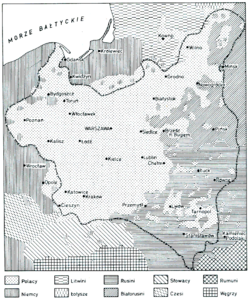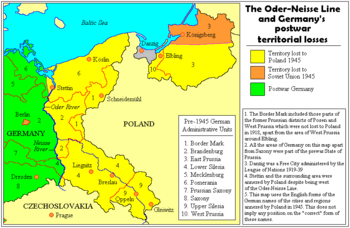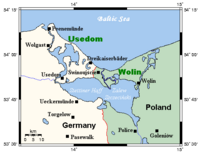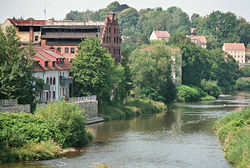Oder-Neisse line
|
||||||||||||||||||||||||||||||||||||||||||||||||||
|
||||||||||||||||||||||||||||||||||||||||||||||||||
The Oder-Neisse line (Polish: Granica na Odrze i Nysie Łużyckiej, German: Oder-Neiße-Grenze) was drawn in the aftermath of World War II as the eastern border of Germany and the western border of Poland. The line is formed primarily by the Oder and Lusatian Neisse rivers, and meets the Baltic Sea west of the seaport cities of Szczecin (German: Stettin) and Świnoujście (Swinemünde). All pre-war German territory east of the line was awarded to Poland and the Soviet Union after the war, and most of its German population was expelled. The line marked the border between the German Democratic Republic and Poland between 1950 and 1990. Since 1990, it has formed the border between reunited Germany and Poland.
Contents |
Pre-war German-Polish border
Before World War II, Poland's western border with Germany had been fixed under the terms of the Treaty of Versailles of 1919. It partially ran along the historic borders of Great Poland, but with certain adjustments that were intended to reasonably reflect the ethnic compositions of small areas beyond the traditional provincial borders. However, eastern Pomerania, Upper Silesia and Masuria had been divided, leaving small areas populated by a rural Slavic population (often Germanized) on the German side and significant German, primarily urban populations on the Polish side. Moreover, the border left Germany divided into two portions by the Polish Corridor and the independent Free City of Danzig, which had a predominantly German urban population, but was split from Germany to help secure Poland's access to the Baltic Sea.
Allied considerations during the war
Tehran Conference
It was Josef Stalin who had first insisted that Poland's western frontier be extended to the Oder River at the Tehran Conference in late 1943. The Americans, however, were not interested in discussing any border changes at that time.[1] British Foreign Secretary Anthony Eden wrote in his diary that "A difficulty is that the Americans are terrified of the subject which [Roosevelt advisor] Harry [Hopkins] called 'political dynamite' for their elections. But, as I told him, if we cannot get a solution, Polish-Russian relations six months from now, with Russian armies in Poland, will be infinitely worse and elections nearer."[2]
Yalta Conference
At the Yalta Conference in 1945, the subject of Poland was again discussed. President Franklin D. Roosevelt said that it would "make it easier for me at home" if Stalin were generous to Poland with respect to Poland's eastern frontiers.[3] Winston Churchill said a Soviet concession on that point would be admired as "a gesture of magnanimity" and declared that, with respect to Poland's post-war government, the British would "never be content with a solution which did not leave Poland a free and independent state."[4] With respect to Poland's western frontiers, Stalin noted that the Polish Prime Minister in exile, Stanisław Mikołajczyk, had been pleased when Stalin had told him Poland would be granted Stettin (Szczecin) and the German territories east of the Western Neisse River.[5] Churchill objected to the Western Neisse frontier saying that "it would be a pity to stuff the Polish goose so full of German food that it got indigestion."[6] He added that many British would be shocked if such large numbers of Germans (more than 11 million) were driven out of these areas, to which Stalin responded that "many Germans" had "already fled before the Red Army."[7] Poland's western frontier was ultimately left to be decided at the Potsdam Conference.
Polish and Soviet demands


Originally, Germany was to retain Stettin, while the Poles were to annex East Prussia with Königsberg (now Kaliningrad). The Polish government had in fact demanded this since the start of World War II in 1939, due to East Prussia's strategic position that undermined the defense of Poland. Other territorial changes proposed by the Polish government were the transfer of the Silesian region of Oppeln (Opole) and the Pomeranian regions of Danzig (Gdańsk), Bütow (Bytów) and Lauenburg (Lębork), and straightening of the border in Western Pomerania.
Eventually, however, Stalin decided that he wanted Königsberg to be added to Soviet territory as a year-round warm water port for the Soviet Navy, and he argued that the Poles should receive Stettin instead. The pre-war Polish government-in-exile had little to say in these decisions, but insisted on retaining the historic Polish city of Lwów (now L'viv) in Galicia, eastern Poland. Stalin refused to concede this, and instead offered Lower Silesia with Breslau (Wrocław). Many people from Lwów would later be moved to populate Gdańsk.
The eventual border was not the most far-reaching territorial change that was proposed. There were proposals to include areas further west so that Poland could include the small minority population of ethnic Slavic Sorbs who lived near Cottbus and Bautzen.
The precise location of the western border was still left open. The western Allies accepted in general the Oder River as the future western border of Poland. The open question was whether the border should follow the eastern or western Neisse River, and whether Stettin (Szczecin), the traditional seaport of Berlin[8] and a city with an exclusively German population, should remain German or be included in Poland (with expulsion of the German population). The western Allies sought to place the border on the eastern Neisse, but Stalin refused. Suggestions of a border on the Bóbr (Bober) river were also rejected by the Soviets.
Potsdam Conference
At the Potsdam Conference, in response to American and British statements that the Poles were claiming far too much German territory, Stanisław Mikołajczyk argued that "the western lands were needed as a reservoir to absorb the Polish population east of the Curzon line, Poles who returned from the West, and Polish people who lived in the overcrowded central districts of Poland." [9] The U.S. and the U.K. were also negative towards the idea of giving Poland an occupation zone in Germany. However on July 29, President Truman handed Molotov a proposal for a temporary solution whereby the U.S. accepted Polish administration of land to the Oder and eastern Neisse until a final peace conference determined the boundary. In return for this large concession, the U.S. demanded that "each of the occupation powers take its share of reparations from its own [Occupation] Zone and provide for admission of Italy into the United Nations." The Soviets stated that they were not pleased "because it denied Polish administration of the area between the two Neisse rivers."[10]
However, on the 29th Stalin asked Bierut to accept, considering the large American concesions. The Polish delegation decided to accept a boundary of the administration zone at "somewhere between the western Neisse and the Queiss (Kwisa)." Later that day the Poles changed their mind; "Bierut, accompanied by Rola-Zymierski, returned to Stalin and argued against any compromise with the Americans. Stalin told his Polish proteges that he would defend their position at the conference."[10]

At the Potsdam Conference the United States, the United Kingdom, and the Soviet Union placed the German territories east of the Oder-Neisse line formally under Polish administrative control.
Polish propaganda[11] came to refer to those territories as the Regained or Recovered Territories, a term alluding to their having been in the possession of the early medieval Piast dynasty of Polish kings or included in the parts lost to Germany during the Partitions of Poland. The creation of a picture of the new territories as an "integral part of historical Poland" in the post-war had the aim of forging Polish settlers and repatriates arriving there into a coherent community loyal to the new Communist Regime.[12] The term was in use immediately following the end of World War II when it was part of the Communist indoctrination of the Polish settlers in those territories.[12] It was anticipated that a final peace treaty would follow shortly, and that would either confirm this border or determine whatever alterations might be agreed upon. It was also decided that all Germans remaining in the new and old Polish territory should be expelled, for various reasons, including prevention of another war. The final agreements in effect compensated Poland for 187,000 square kilometers of land located east of the Curzon line – Polish areas annexed by the Soviet Union (in which ethnic Poles supposedly comprised a mere 36.5% of the population) – with 112,000 km² of former German territories.
One reason for this version of the new border was the fact that it was the shortest possible border between Poland and Germany. It is only 472 kilometers in length, stretching from the northernmost point of the Czech Republic to one of the southernmost points of the Baltic Sea in the Oder River estuary. The rights of the inhabitants of the formerly German territories, some of the people themselves originally of Slavic origin, were disregarded by the victorious powers and the Communist regime installed by Soviets in Poland, who sometimes also expelled Masurians, Slovincians, some Kashubians, and Slavic Upper Silesians as "Germans".

At Potsdam, Stalin argued for the Oder-Neisse line on the grounds that the Polish Government demanded this frontier and that there were no longer any Germans left east of this line, a claim that prompted Admiral William D. Leahy, American President Truman's Chief of Staff, to whisper "The Bolshies have killed them all", into President Truman's ear.[13] Later the Russians admitted that at least "a million Germans" (still far lower than the true number) still remained in the area at that time. Several Polish leaders appeared at the conference to advance arguments for an Oder–Western Neisse frontier. Szczecin was demanded for Eastern European exports. If Szczecin were Polish, then "in view of the fact that the supply of water is found between the Oder and the Lausitzer Neisse, if the Oder's tributaries were controlled by someone else the river could be blocked."[14]
President Harry S. Truman and British Prime Minister Clement Attlee said that they could not tolerate Polish administration of part of one of the occupation zones (effectively making Poland a fifth occupying power after the U.S., Britain, France, and the Soviet Union) and the expulsion of millions of German people from it into other areas.[15] Stalin responded that the Poles "were taking revenge for the injuries which the Germans had caused them in the course of centuries."[16]
James Byrnes – who had become the American Secretary of State earlier that month – later advised the Soviets that the U.S. was prepared to concede the area east of the Oder River and the Eastern Neisse (Nysa Kłodzka) River to Polish administration, and for it not consider it part of the Soviet occupation zone, in return for a moderation of Soviet demands for reparations from the Western occupation zones.[17] A Nysa Kłodzka boundary would have left Germany with roughly half of Silesia. The Soviets insisted that the Poles would not accept this. The Polish representatives (and Stalin) were in fact willing to concede a line following the Oder-Bober-Queiss (Odra-Bóbr-Kwisa) rivers through Żagań (Sagan) and Lubań (Lauban), but even this small concession ultimately proved unnecessary, since on the next day, Byrnes told the Soviet Foreign Minister Vyacheslav Molotov that the Americans would reluctantly concede to the Western Neisse.[18] Byrnes's concession undermined the British position, and although the British Foreign Secretary Ernest Bevin raised objections,[19] the British eventually agreed to the American concession.
Winston Churchill was not present at the end of the Conference, since the results of the British elections had made it clear that he had been defeated. Churchill later claimed that he would never have agreed to the Oder–Western Neisse line, and in his famous Iron Curtain speech declared that "The Russian-dominated Polish Government has been encouraged to make enormous and wrongful inroads upon Germany, and mass expulsions of millions of Germans on a scale grievous and undreamed-of are now taking place."[20]
World War II aftermath

Under the territorial changes, the border was moved westward deep into territory which was formerly part of Germany and populated by a German population, to a line which placed almost all of Silesia, more than half of Pomerania, the eastern portion of Brandenburg and a small area of Saxony within Poland (see Former eastern territories of Germany). Polish gains also included the former Free City of Danzig and the southern two-thirds of East Prussia (Masuria and Warmia), also with mainly German populations. (The northeastern third of East Prussia was directly annexed by the Soviet Union, with the Memelland becoming part of the Lithuanian SSR and the bulk of the territory forming the new Kaliningrad Oblast of the Russian SFSR.)
The territorial changes were followed by large-scale population transfers and ethnic cleansing carried out by the Polish government and military, which resulted in the expulsion of nearly all Germans from the territory annexed by Poland and the Soviets, and the return to Poland of the Polish displaced persons then inside Allied-occupied Germany. In addition to this, the Polish population from the eastern half of the former Second Polish Republic, now annexed by the Soviet Union, was mostly expelled and transferred to the newly acquired Oder-Neisse territories.
This process brought about one of the largest ethnic cleansings in human history, with 14 million people either deported or prevented from returning to their homes after cessation of fighting. The removal of German citizens from the annexed territories was carried out with much brutality, including gang-rape, child-abuse, theft, torture, terror, and mass murder.[21] Of the 14 million ethnic Germans deported, only 12 million arrived in the four Occupation Zones of Germany. About two million were murdered or went missing in the wake of the ethnic cleansing.[21]
Few Poles have opposed the territorial gains from Germany and the expulsion of the indigenous German inhabitants. These developments have been presented as a just consequence for the Nazi German state's starting the war and conducting genocide, as well as for the territorial losses of eastern Poland to the Soviet Union. With respect to the expelled ethnic German minority in Poland, resentment has been based on their majority's loyalty to the German Reich during the invasion and occupation, and the active role played by some in the persecution and mass murder of Poles and Jews. These circumstances have impeded sensitivity among Poles with respect to the injustices committed during the aftermath of World War II.
The new order was in Stalin's interests, because it enabled the Soviet Union to present itself as the primary maintainer of Poland's new western border.
Recognition of the border by Germany

The East German Socialist Unity Party (SED), founded 1946, rejected the Oder-Neisse line. Under Soviet occupation and heavy pressure by Moscow, the official phrase Friedensgrenze (border of peace) was promulgated in March–April 1947 at the Moscow Foreign Ministers Conference. On 11 January 1949, the formerly German, now Polish "New Territories" were formally annexed by the Communist Polish government. The German Democratic Republic under Soviet occupation, and Poland's Communist government, signed the Treaty of Zgorzelec in 1950, recognizing the Oder-Neisse line, officially designated by the Communists as the "Border of Peace and Friendship".[22]
Decades later, in 1989, another treaty was signed between Poland and East Germany, the sea border was defined, and a dispute from 1985 was settled.
In 1952, recognition of the Oder-Neisse line as a permanent boundary was one of Stalin's conditions for the Soviet Union to agree to a reunification of Germany. The offer was rejected by the West German Chancellor Konrad Adenauer. Even in 1950, France declared the eastern borders of 1937 as applicable and relevant to Germany, and the United Kingdom and the United States condemned the 1950 Treaty of Zgorzelec between East Germany and Poland that established the Oder-Neisse Line between the two states.
In West Germany, where the majority of the 12 million displaced refugees had settled, recognition of the Oder-Neisse Line as permanent was long regarded as unacceptable. In fact, under the Hallstein Doctrine, West Germany recognized neither the government of Communist Poland, nor the German Democratic Republic (East Germany).
In 1963 the German opposition leader Willy Brandt said that "abnegation is betrayal". But it was Brandt who eventually changed West Germany's attitude with his policy of Ostpolitik. In 1970 West Germany signed treaties with the Soviet Union (Treaty of Moscow) and Poland (Treaty of Warsaw) recognizing the Oder-Neisse line between Germany and Poland as current reality, not to be changed by force. This had the effect of making family visits by the displaced eastern Germans to their lost homelands now more or less possible. Such visits were still very difficult, however, and permanent resettlement in Poland remained impossible.
In November 1990, after German reunification, the Federal Republic of Germany and the Republic of Poland signed a treaty confirming the border between them, as requested by the Treaty on the Final Settlement With Respect to Germany. Earlier, Germany had amended its constitution and abolished Article 23 of West Germany's Basic Law (on which reunification was based), which could have been used to claim the former German eastern territories.
The 1990 German-Polish Border Treaty finalizing the Oder-Neisse line as the Polish-German border[23] came into force on January 16, 1992, together with a second one, a Treaty of Good Neighbourship, signed in June 1991, in which the two countries, among other things, recognized basic political and cultural rights for both the German and the Polish minorities living on either side of the border. After 1990, approximately 150,000 people registered as Germans still reside in the areas transferred to Poland, mainly in the Opole (Oppeln) Voivodeship, with a smaller presence in regions such as Lower Silesia and Warmia-Masuria. There are one and a half million Poles or ethnic Poles living in Germany, including both recent immigrants and those that have lived in Germany for centuries.
See also
- Curzon Line
- Expulsion of Germans after World War II
- Federation of Expellees
- Union of Poles in Germany
- Vistula-Oder Offensive, from January 12 until February 2, 1945
- Malta Conference, from January 30 to February 3, 1945
- Yalta Conference, from February 4 to February 11, 1945
- Battle of Königsberg, from April 6 until April 9, 1945
- Battle of the Oder-Neisse, from April 16 until April 19, 1945
- Potsdam Conference, from July 17 to August 2, 1945
Further reading
- An East German pamphlet for propagandists entitled "Why is the Oder-Neiße Line a Peace Border?"
- CNN Cold War - The Oder-Neisse Line: Ethnic cleansing, 1940s style
- Treaty between the Federal Republic of Germany and the Republic of Poland on the confirmation of the frontier between them, 14 November 1990(PDF) (Treaty confirming the border between Germany and Poland (Warsaw, November 14, 1990) in Polish and German)
- The Oder Neisse Line Problem (German) (PDF)
- Closing The Ring Winston Churchill; Excerpt on the Teheran conference, from his memoirs.
- Speaking Frankly James F. Byrnes; Excerpt on the Yalta conference, from his memoirs.
- Triumph and Tragedy Winston Churchill; Excerpt on the Yalta conference, from his memoirs.
- Churchill's statement to the House of Commons 27, February, 1945, Describing the outcome of Yalta
- Statistics Of Poland's Democide Democide Addenda By R.J. Rummel
- The German-Polish Border Region. A Case of Regional Integration? ARENA Working Papers WP 97/19 Jorunn Sem Fure Department of History, University of Bergen
- Minority Rights Abuse in Communist Poland and Inherited Issues
- "Dismember or Dismantle", Time Magazine February 21, 1944
Footnotes
- ↑ US State Department, Foreign Relations of the US: The Conference at Cairo and Tehran 1943, "Tripartite Dinner Meeting, 28 November 1943" pp. 509-14
- ↑ Anthony Eden, The Reckoning (London, 1965) p. 427.
- ↑ US Dept. of State, Foreign Relations of the US, The Conferences at Malta and Yalta, 1945, Third Plenary Meeting 6 February 1945, Matthews Minutes, p. 77
- ↑ Ibid., Bohlen Minutes, p. 669.
- ↑ Llewellyn Woodward, British Foreign Policy in the Second World War, (London, 1962) p. 299
- ↑ Winston Churchill and the Soviet Union during the Second World War - The Churchill Centre
- ↑ http://links.jstor.org/sici?sici=0002-8762(197410)79%3A4%3C1119%3ATCWWO%3E2.0.CO%3B2-1
- ↑ Lebensraum, Time Magazine 13 August 1945
- ↑ Richard C. Lukas Bitter Legacy: Polish-American Relations in the Wake of World War II. p 16
- ↑ 10.0 10.1 Richard C. Lukas Bitter Legacy: Polish-American Relations in the Wake of World War II. p.17
- ↑ An explanation note in "The Neighbors Respond: The Controversy Over the Jedwabne Massacre in Poland", ed. by Polonsky and Michlic, p.466
- ↑ 12.0 12.1 Martin Åberg, Mikael Sandberg, Social Capital and Democratisation: Roots of Trust in Post-Communist Poland and Ukraine, Ashgate Publishing, Ltd., 2003, ISBN 0754619362, Google Print, p.79
- ↑ Harry Truman, Year of Decisions, (New York, 1955) p. 296
- ↑ US Dept of State, Foreign Relations of the US, The Conference of Berlin (Potsdam) 1945, vol. II pp. 1522-1524.
- ↑ Ibid., pp. 381ff
- ↑ Ibid., p. 384
- ↑ Ibid., p. 1150
- ↑ (Ibid., p. 480)
- ↑ Ibid., p. 519
- ↑ Churchill's Iron Curtain, On expulsion of ethnic Germans - historyguide.org
- ↑ 21.0 21.1 de Zayas, Alfred-Maurice: A Terrible Revenge: The Ethnic Cleansing of the Eastern European Germans 1944-1950, New York: St. Martin's Press, 1994
- ↑ Why is the Oder-Neiße Line a Peace Border? (1950)
- ↑ Treaty between the Federal Republic of Germany and the Republic of Poland on the confirmation of the frontier between them, 14 November 1990(PDF)

